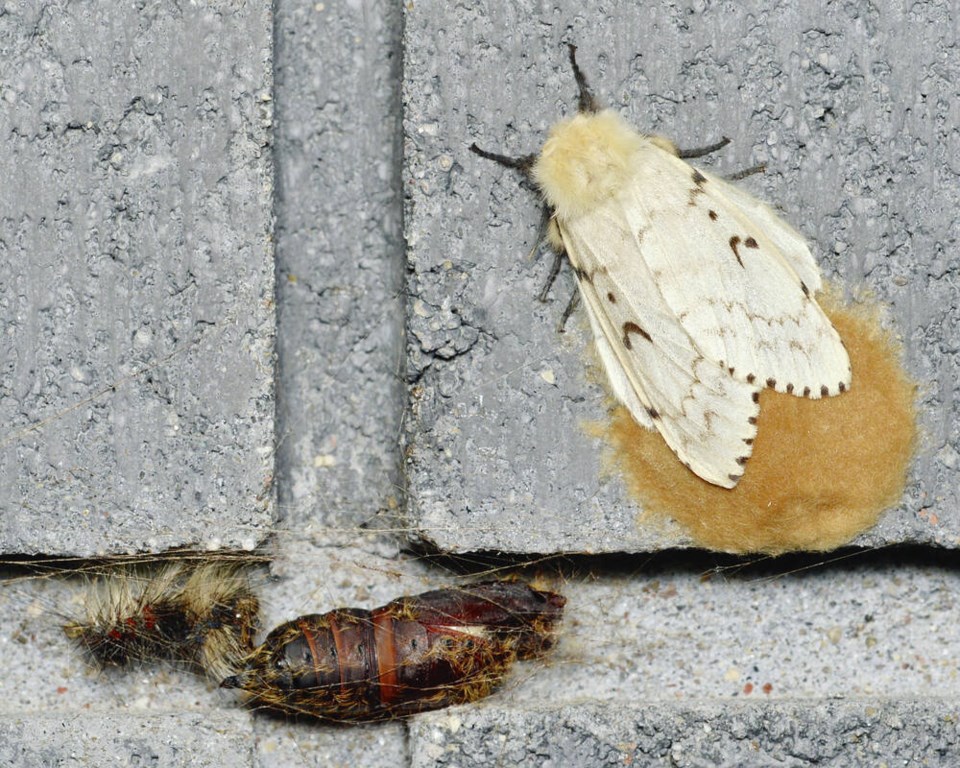When I saw a picture of Lymantria dispar for the first time, her bleached-blond Tina Turner locks obscured her eyes and her white-and-brown-striped cloak draped down her back and sides.
It also helped that an entomologist friend pointed her out.
“That’s a female Lymantria dispar,” he said. He also used the common name she’d long been called that referred to a travelling people but has since been changed officially to spongy moth.
“And here’s the male,” he said, tapping the photo.
The male moth was noticeably darker. His grey-beige wings had thick brown zigzag stripes and were held flat to the sky like solar panels. And instead of a Tina Turner mop, he wore, as all male moths do, a headdress with two feathery antennae sticking up.
With their striking patterning and head styles, the critters easily could hold their own on an insect version of a New York catwalk.
But Lymantria dispar is not a fashion statement that’s desired in B.C.
The variety of spongy moth I was shown originates from Europe. It feasts on deciduous broadleaved trees and is considered a serious threat to forests, farms, orchards and urban trees.
Another variety comes from Asia. It has broader tastes, chowing down on both conifers and broad-leafed plants.
Last spring and summer’s bounty of caterpillars indicated the region was in the midst of a forest tent caterpillar outbreak. Apparently, however, some parts of the Island were also experiencing infestations by spongy moth.
Trapping and monitoring data from 2023 reveal populations of Lymantria dispar continue to grow on the south Island. North Saanich, the Gorge-Tillicum area of Victoria and Saanich, Esquimalt, and the Colwood-Langford area all have been found to harbour growing infestations of the moth this winter. Salt Spring Island, Nanaimo and Qualicum Beach, as well as places across southern B.C., also have infestations.
Because of the damage they do, neither variety is welcome in B.C.
The province and its partners on the B.C. Spongy Moth Technical Advisory Committee, a group of B.C. and federal entomologists and other experts, undertake regular, annual trapping and monitoring across the province to catch new introductions of the moth in B.C. and suppress and eradicate spot infestations before the species becomes established.
The threat is not just to forests, farms, orchards and gardens and the food, products, goods and livelihoods that come from them. Many countries and regions include Lymantria dispar on their “unwanted and unwelcome” lists.
If B.C. were to become known as spongy moth territory, the trade and plant-health protection measures would be costly and onerous for anyone travelling or shipping goods from the province.
To protect Greater Victoria’s forests, farms, parks and neighbourhood trees, the B.C. Ministry of Forests is planning to treat more than 650 hectares of the region’s residential and municipal areas in the coming months.
They’ll use aircraft to apply a biological insecticide called Foray 48B. The active, moth-controlling ingredient is Bacillus thuringiensis var. kurstaki (Btk), a species of bacteria found naturally in soil and commonly used to control caterpillar pests in organic agriculture.
The treatment is effective at eradicating spongy moths and affects only moth and butterfly caterpillars that eat sprayed leaves.
First introduced in Massachusetts in 1869 by a French naturalist in Massachusetts who was trying to cross the species with North American silkworms, the moth has spread across and become established in the northeastern U.S, Ontario, Quebec and the Maritime provinces. Those areas now serve as the main source of Lymantria infestations in B.C.
The non-native and invasive moths typically arrive in B.C. as egg masses laid on vehicles, boats, and campers in infested areas. When the owners of those vehicles, etc., drive to balmy B.C. to escape nasty eastern winters, the egg masses come along, too. Then spring comes, the eggs hatch, and the caterpillars start gorging themselves on our shrubberies.
During the last few years, Ontario and Quebec have experienced spongy moth outbreaks. The record numbers of spongy moths trapped in B.C. annually since 2022 originate from those eastern outbreaks.
The B.C. Ministry of Forests treatment plan is available for viewing online at gov.bc.ca/spongymoth. The B.C. Spongy Moth Technical Advisory Committee has also been holding online open houses to answer residents’ questions about spongy moth and the planned eradication projects.
>>> To comment on this article, write a letter to the editor: [email protected]



